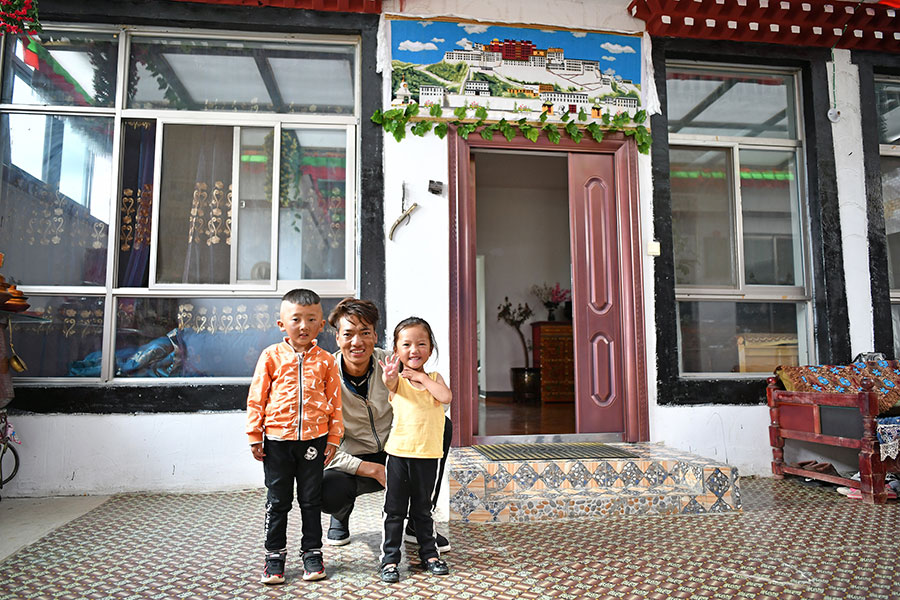
A father and his two children pose for a photo in front of their new house in Tashi Dushi village, a two-hour drive from downtown Lhasa, the capital of the Tibet autonomous region. The village was constructed to accommodate herders who were relocated. [Photo/Xinhua]
In a narrow workshop built outside rows of neatly arranged two-story villas, Phuntsok Tsering was offering guidance to villagers learning Tibetan embroidery.
The 37-year-old has been running an embroidery cooperative for three years in a newly constructed village named Tashi Dushi, or happiness all year round. The village is a two-hour drive from downtown Lhasa, capital of the Tibet autonomous region.
For all of his students, with most of them having relocated from several high altitude locations, Phuntsok Tsering repeatedly stresses that there should be no room for error in their needlework if they wish to get good prices for their work. These include tapestries, curtains and apron-like accessories that Tibetan women wear.
Originating in the 9th century, Tibet's embroidery features highly religious subjects ranging from Buddha to monasteries and the holy Potala Palace, which towers over downtown Lhasa against a backdrop of rolling mountains.
"The color of thread filling for Buddha's skirts must be exactly the same as the one from the thangka," said Phuntsok Tsering, referring to the ancient Tibetan Buddhist painting.
"The width of the ribbons should also be accurate, otherwise it will be a failure-in a cultural sense and monetary as well."
An exquisite tapestry requires 15 days of work by a skilled embroider and can fetch thousands of yuan. That is a good salary for Phuntsok Tsering's apprentices, considering that not long ago many people were still impoverished by national standards-defined as living on less than 2,300 yuan ($328) a year.
In a village of relocated farmers and herders, Phuntsok Tsering's workshop has offered plenty of opportunities for locals to socialize, to be in awe of their own legacy, while at the same time increase their incomes during cold seasons when job opportunities are rare. Phuntsok Tsering started his eight years of studying religious painting and needlework at age 22, with a master in Qamdo, Tibet.
Tsedrub, 45, who was bent over an embroidered apron at a sewing machine, said she liked to be at the workshop in the winter. People would sit idle if not for Phuntsok Tsering's cooperative, she said.
Phuntsok Tsering and Tsedrub were among hundreds of people who applied for a place in a relocation program aimed at helping farmers and herders who live in isolated places escape poverty.
In 2016, each family was given a two-story house, decorated with colorful cloths in traditional Tibetan style. They were also offered jobs at a nearby base for growing medicinal herbs and a cattle farm.
To diversify available jobs, local authorities offered incentives to Phuntsok Tsering, providing him a space free of charge, and exempting his workshop from electricity and water bills, in the hope that he could teach his trade to more villagers.
"I now have five villagers on board," he said. "I am happy to see people lead better lives because of Tibetan embroidery."
|






7740f3b5-9ecb-438e-9052-76cb2d4bb671.jpg)

